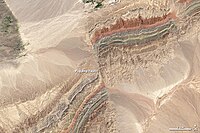
Photo from wikipedia
17 The 2017 Tehuantepec earthquake (Mw 8.2) was the first great normal fault event 18 ever instrumentally recorded to occur in the Middle America Trench. The earthquake 19 generated a… Click to show full abstract
17 The 2017 Tehuantepec earthquake (Mw 8.2) was the first great normal fault event 18 ever instrumentally recorded to occur in the Middle America Trench. The earthquake 19 generated a tsunami with an amplitude of 1.8 m (height=3.5 m) in Puerto Chiapas, Mexico. 20 Tsunami waveforms recorded at coastal tide gauges and offshore buoy stations were used to 21 estimate the optimum sea surface displacement without assuming any fault. Our optimum sea 22 surface displacement model indicated that the maximum uplift of 0.5 m is located near the 23 trench and the maximum subsidence of 0.8 m on the coastal side near the epicenter. We then 24 estimated the fault slip distribution that can best explain the optimum sea surface 25 displacement assuming ten different fault geometries. The best model suggests that a 26 compact region of large slip (3 – 6 m) extends from a depth of 30 km to 90 km, centered at a 27 depth of 60 km. 28 29
Journal Title: Geophysical Research Letters
Year Published: 2017
Link to full text (if available)
Share on Social Media: Sign Up to like & get
recommendations!